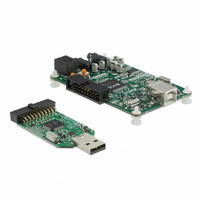USB AUDIO 2.0 REFERENCE DESIGN XMOS, USB AUDIO 2.0 REFERENCE DESIGN Datasheet - Page 20

USB AUDIO 2.0 REFERENCE DESIGN
Manufacturer Part Number
USB AUDIO 2.0 REFERENCE DESIGN
Description
USB AUDIO 2.0 REFERENCE DESIGN
Manufacturer
XMOS
Datasheets
1.USB_AUDIO_2.0_REFERENCE_DESIGN.pdf
(18 pages)
2.USB_AUDIO_2.0_REFERENCE_DESIGN.pdf
(6 pages)
3.USB_AUDIO_2.0_REFERENCE_DESIGN.pdf
(2 pages)
4.USB_AUDIO_2.0_REFERENCE_DESIGN.pdf
(57 pages)
Specifications of USB AUDIO 2.0 REFERENCE DESIGN
Design Resources
USB AUDIO Schematic
Main Purpose
Audio, Audio Processing
Embedded
Yes
Utilized Ic / Part
XS1-L1
Primary Attributes
Audio data up to 24-bit @ 192kHz
Secondary Attributes
I²S and S/PDIF
Lead Free Status / RoHS Status
Lead free / RoHS Compliant
Other names
880-1017
The audio system sends a word over a channel to the decouple thread to request
The first operation the interrupt handler does is to send back a word acknowledging
The complete communication scheme is shown in the table below (for non sample
USB Audio Software Design Guide
Decoupler/Audio thread interaction
system, the decoupler thread must respond to requests from the audio system
to send/receive samples immediately. An interrupt handler is set up in the de-
coupler thread to do this. The interrupt handler is implemented in the function
handle_audio_request .
sample transfer (using the build in outuint function). The receipt of this word in the
channel causes the
the request (if there was a change of sample frequency a control token would instead
be sent—the audio system uses a testct() to inspect for this case).
Sample transfer may now take place. First the audio subsytem transfers sam-
ples destined for the host, then the decouple thread sends samples from the host
to device. These transfers always take place in channel count sized chunks (i.e.
NUM_USB_CHAN_OUT and NUM_USB_CHAN_IN ). That is, if the device has 10 output chan-
nels and 8 input channels, 10 samples are sent from the decouple thread and 8
received every interrupt.
frequency change case):
handle_audio_request interrupt to fire.
To meet timing requirements of the audio
Document Revision 1.2
20/57



















